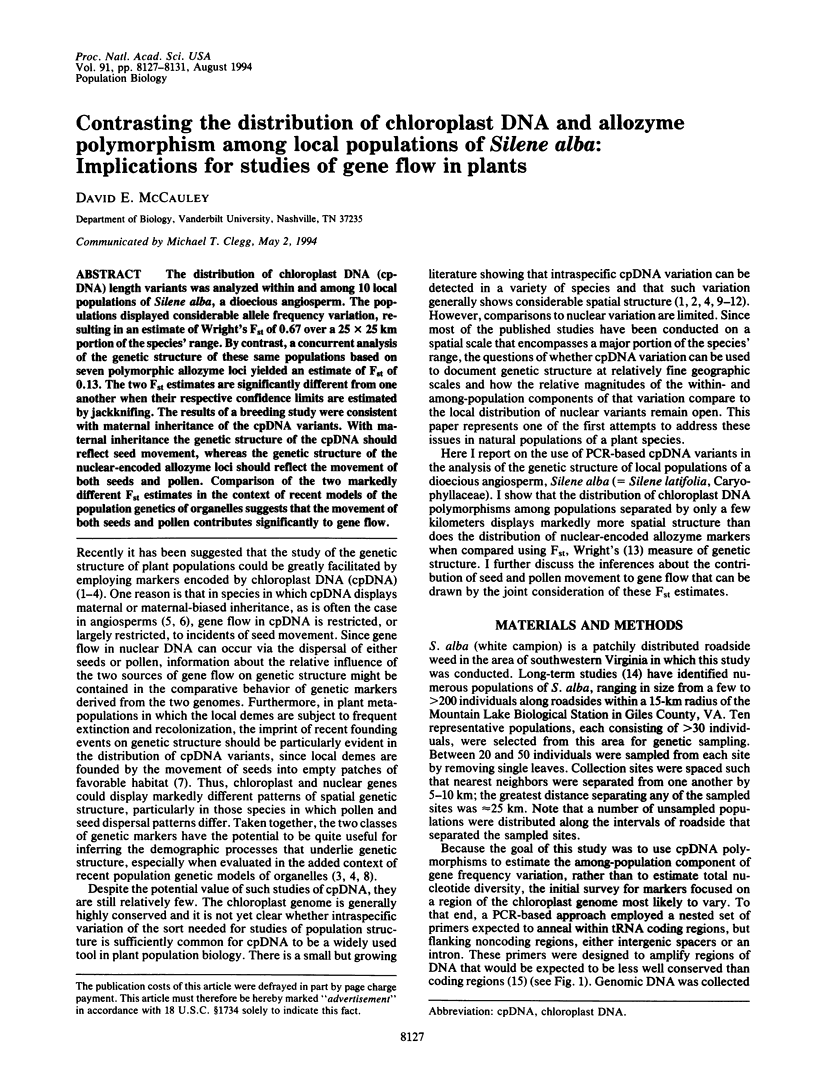Contrasting the distribution of chloroplast DNA and allozyme polymorphism among local populations of Silene alba: implications for studies of gene flow in plants (original) (raw)
Abstract
The distribution of chloroplast DNA (cp-DNA) length variants was analyzed within and among 10 local populations of Silene alba, a dioecious angiosperm. The populations displayed considerable allele frequency variation, resulting in an estimate of Wright's Fst of 0.67 over a 25 x 25 km portion of the species' range. By contrast, a concurrent analysis of the genetic structure of these same populations based on seven polymorphic allozyme loci yielded an estimate of Fst of 0.13. The two Fst estimates are significantly different from one another when their respective confidence limits are estimated by jackknifing. The results of a breeding study were consistent with maternal inheritance of the cpDNA variants. With maternal inheritance the genetic structure of the cpDNA should reflect seed movement, whereas the genetic structure of the nuclear-encoded allozyme loci should reflect the movement of both seeds and pollen. Comparison of the two markedly different Fst estimates in the context of recent models of the population genetics of organelles suggests that the movement of both seeds and pollen contributes significantly to gene flow.

Images in this article
Selected References
These references are in PubMed. This may not be the complete list of references from this article.
- Birky C. W., Jr, Fuerst P., Maruyama T. Organelle gene diversity under migration, mutation, and drift: equilibrium expectations, approach to equilibrium, effects of heteroplasmic cells, and comparison to nuclear genes. Genetics. 1989 Mar;121(3):613–627. doi: 10.1093/genetics/121.3.613. [DOI] [PMC free article] [PubMed] [Google Scholar]
- Hale L. R., Singh R. S. Mitochondrial DNA variation and genetic structure in populations of Drosophila melanogaster. Mol Biol Evol. 1987 Nov;4(6):622–637. doi: 10.1093/oxfordjournals.molbev.a040466. [DOI] [PubMed] [Google Scholar]
- Hong Y. P., Hipkins V. D., Strauss S. H. Chloroplast DNA diversity among trees, populations and species in the California closed-cone pines (Pinus radiata, Pinus muricata and Pinus attenuata). Genetics. 1993 Dec;135(4):1187–1196. doi: 10.1093/genetics/135.4.1187. [DOI] [PMC free article] [PubMed] [Google Scholar]
- Karl S. A., Avise J. C. Balancing selection at allozyme loci in oysters: implications from nuclear RFLPs. Science. 1992 Apr 3;256(5053):100–102. doi: 10.1126/science.1348870. [DOI] [PubMed] [Google Scholar]
- Sears B. B. Elimination of plastids during spermatogenesis and fertilization in the plant kingdom. Plasmid. 1980 Nov;4(3):233–255. doi: 10.1016/0147-619x(80)90063-3. [DOI] [PubMed] [Google Scholar]
- Slatkin M. Gene flow and genetic drift in a species subject to frequent local extinctions. Theor Popul Biol. 1977 Dec;12(3):253–262. doi: 10.1016/0040-5809(77)90045-4. [DOI] [PubMed] [Google Scholar]
- Taberlet P., Gielly L., Pautou G., Bouvet J. Universal primers for amplification of three non-coding regions of chloroplast DNA. Plant Mol Biol. 1991 Nov;17(5):1105–1109. doi: 10.1007/BF00037152. [DOI] [PubMed] [Google Scholar]
- Taylor D. R. The genetic basis of sex ratio in Silene alba (= S. latifolia). Genetics. 1994 Feb;136(2):641–651. doi: 10.1093/genetics/136.2.641. [DOI] [PMC free article] [PubMed] [Google Scholar]